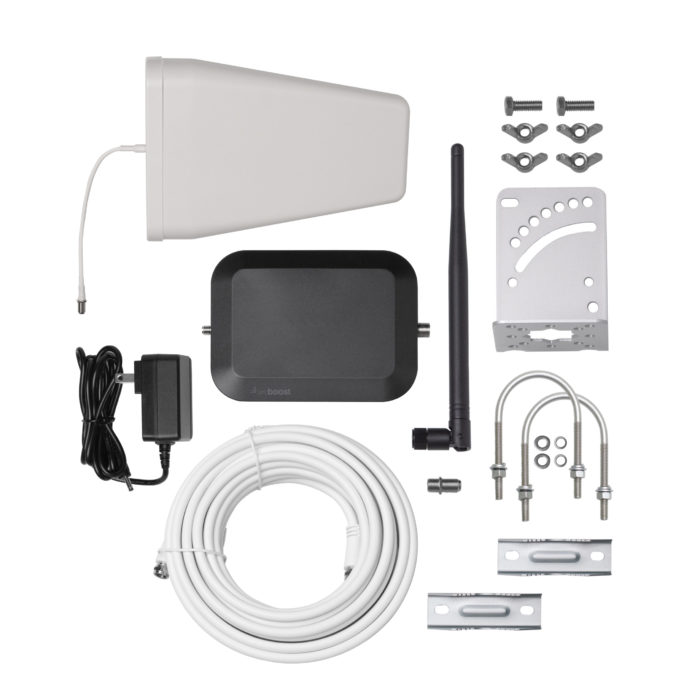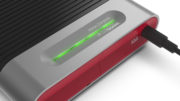Cell boosters have been around for a while. But, while cell boosters for large spaces have continued to be popular, it seems like it’s hard to get a reliable booster for a small space. Most of the options are boosters from overseas which lack carrier certification. What’s more most of them don’t work very well.
Along comes the weBoost Home Studio.

The Home Studio is a compact 65dB booster that uses a lot of off-the-shelf parts to keep the price down. Other than the booster itself, which is the black rectangle in the middle of this photo, all the other parts are standard Wilson/weBoost parts that have been around for some time. Even the antenna seems to be the same design that Wilson has been using for its signal detectors for some time.
How is this booster different from other weBoost boosters?
This booster has the same 65dB gain as the Home MultiRoom. The more expensive Home Multiroom has a larger indoor antenna and a more advanced outdoor antenna. I can’t confirm it, but I also suspect that the Home Multiroom has more broadcast power.
The Home Studio is designed for areas where you only need boost in one or two rooms. weBoost calls this a single-room booster, and recommends that if you want to get boost in your home that you use a larger booster like the Home Multiroom or Home Complete.
How well does it work?
I put the Home Studio to the test to try to figure out if it lives up to the hype. As with all my tests, these are real-world numbers, not lab numbers. I want to give you some idea how this booster stacks up in the real world.
Testing parameters
This booster uses the same Wilson outdoor antenna that is normally used at our West Coast testing facility, so the older antenna and existing cabling was used. The test facility is a wooden building covered with stucco where outdoor cell service ranges from -65dB to -85dB and indoor service ranges from -85dB to -105dB. This makes it an ideal location for cellular booster testing.
A WilsonPRO Signal Meter was used for all testing. This is a quad-band signal meter that is capable of detecting PCS, cell, AWS, and LTE frequencies from 700-2100MHz. Upstream AWS performance was not tested because the signal meter itself is not capable of broadcasting, only of reception.
Measurements of all bands were taken at 3, 6, and 9 feet away with the meter in clear view of the booster. Readings for every frequency in the band were averaged. Then, measurements were taken at 3,6, and 9 feet away from the booster without the booster powered up. The same averages were taken, and the difference between the unboosted and boosted numbers was represented as gain.
3 feet from the booster

Three feet should be an ideal distance to test a cell booster. It’s possible to be closer, but the signal diminishes so quickly that it would be hard to get real, dependable measurements.
Here you see that the overall gain is really good. You’re seeing 35-40dB gain across all frequencies and that’s enough to turn one bar into maximum bars.
6 feet from the booster

Six feet is a typical distance for someone who is working in a small office. The booster could be located in a corner, and that means you would want to have really passable service throughout the room.
Here the Home Studio doesn’t disappoint. Its strongest gain is in the cell and LTE frequencies, which are the ones most often used today. The PCS frequencies are far less used and the AWS frequencies aren’t used everywhere.
Solid 20dB gain means that you should get good calls and fast data any time you’re in the same room as this booster.
9 feet from the booster

At nine feet away, you would expect that you would be at the limit of what this booster can do for you. And really, you’d be right. There’s still surprising coverage in the LTE and cell frequencies, but it’s diminished from where it was even three feet closer. PCS and AWS gain is largely gone.
Still, this is proof that you can be in a large single room or even in a second room and get good cell service with this booster.
12 feet from the booster
At twelve feet there was no meaningful gain from this booster. And that’s what I expected to get.
Is this booster right for you?
If you need to get great cell service in a single room, this is the booster to buy. If you need more than that, an investment in a larger booster is a much better option.
Also, if you’re trying to convince someone else that they need a booster and you don’t think they’d read a long article, here’s a video that shows the same thing.





